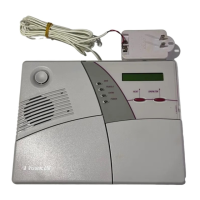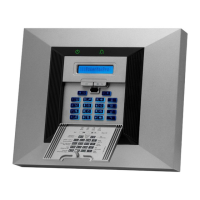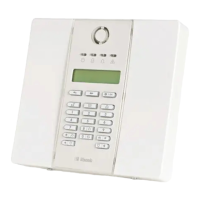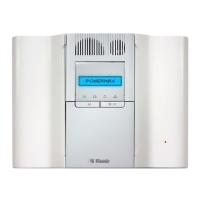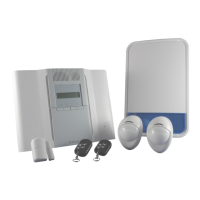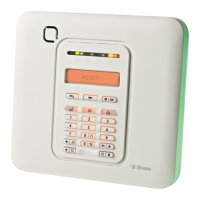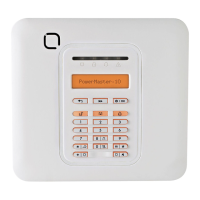DE5467IP 17
4.5.15 Ring Back Time (fig. 4.5, location 15)
Here you determine the period during which the central
station can establish 2-way voice communication with the
PowerMax+ (after 1 ring), if:
A. Alarm type message was received by central station.
B. Ring Back function was selected (see par. 4.5.14).
The options are: 1, 3, 5 or 10 min. (see note in fig. 4.5).
4.5.16 Dialing Attempts (fig. 4.5, location 16)
Here you determine how many times the communicator will
dial the central station’s number. (see note in fig. 4.5).
The options are: 2, 4, 8, 12, and 16 attempts.
Attention! A maximum of 2 dialing attempts is permitted
by the Australian Telecommunication Authority.
In UL installations, dialing attempts should be set to 8.
4.5.17 Set Private Tel. No. (fig. 4.5, location
17)
Here you program the four telephone numbers (including
area code) of the private subscriber to which the system
will report the event groups defined in Location 20.
4.5.18 Two-Way Voice - Private Phones
(fig. 4.5, location 18)
Here you determine whether 2-way voice communication
with private telephones will be allowed or not.
The two options are: enable 2-way and disable 2-way.
In UL installations, this function must be disabled.
4.5.19 Private Tel. Dialing Attempts
(fig. 4.5, location 19)
Here you determine how many times the communicator will
dial the called party’s number (private telephone).
The options are: 1, 2, 3 and 4 attempts.
Attention! A maximum of 2 dialing attempts is permitted
by the Australian Telecommunication Authority.
4.5.20 Reporting to Private Telephones
(fig. 4.5, location 20)
Here you determine which event groups will be reported to
private telephone subscribers. The options are as follows:
Term Description
all All messages
all (-op/cl) All messages, except open/close
all (-alerts) All messages, except alerts
alarms Alarm messages
alerts Alert messages
op/cl Open/close
disable report No message will be reported
Note: “All” means all events including the L. BAT and AC
FAIL trouble messages.
4.5.21 Tel. Acknowledge (fig. 4.5, location 21)
Here you determine whether the system will use the
single acknowledge
or the all acknowledge mode when
reporting to private telephones.
Note: In the single acknowledge
mode, receiving an
acknowledge signal from a single telephone is sufficient to
consider the current event closed and call off the
communication session. The remaining telephones serve
for backup purposes only. In the all acknowledge
mode, an
acknowledge signal must be received from each telephone
before the current event is considered reported.
The options are: single ack and all ack
4.5.22 Pager Tel. No. (fig. 4.5, location 22)
Here you program the telephone number (including area
code) of the pager to which the system will report (if any).
4.5.23 Pager’s PIN No. (fig. 4.5, location 23)
Here you enter the pager’s PIN code - a digital sequence
that is the pager’s address. The paging company’s
computer needs this input for routing messages to the
specific pager. The PIN sequence precedes any digital
message that the PowerMax+ sends to the pager to report
an event. It may include digits, pauses and special
characters (
∗
or #). Call the paging company to find out
what the pager’s PIN code should consist of.
Important! In this location, special characters can be
entered as shown below:
To Insert Keying Sequence Character Displayed
∗
<#>
⇒
<1> B
# <#>
⇒
<2> C
5 sec pause <#>
⇒
<3> E
Enter the pager’s PIN number (up to 16 digits, including
special characters, depending on pager system protocol).
4.5.24 Reporting to a Pager (fig. 4.5, loc. 24)
Here you determine which event groups will be reported to
the pager. (For the abbreviations, refer to par. 4.5.11).
The options are: all alarms + alerts all (- op/cl)
trbl + op/cl trbl op/cl disable report
4.5.25 Recent Closure (fig. 4.5, location 25)
Here you enable or disable the “recent closing” report, that
is sent to the central station if an alarm occurs within 2
minutes from the expiry of the exit delay.
The options are: recent close ON and recent close OFF.
4.5.26 Remote Access (fig. 4.5, location 26)
Here you give or deny permission to access the system
and exercise control from a remote telephone.
The options are: rem. access ON and rem. access OFF.
4.5.27 Mast. DL Code (fig. 4.5, location 27)
Here you determine the master installer 4-digit password
for downloading/uploading data into/from the PowerMax+
memory. (See note in fig. 4.5).
Attention! If "0000" is used, it will not enable
connection of the PowerMax+ to the PC for
upload/download purpose.
4.5.28 Inst. DL Code (fig. 4.5, location 28)
Here you determine the installer 4-digit password for
downloading data into the PowerMax+ memory.
Attention! If "0000" is used, it will not enable
connection of the PowerMax+ to the PC for
upload/download purpose.
4.5.29 Unit ID (fig. 4.5, location 29)
(For future use - identification code for PowerMax+ system
that is connected with several systems in a network).
4.5.31 Upload Option
(fig. 4.5, location 31)
Here you determine whether the PowerMax+ data can be
uploaded into a computer while the system is in disarm
state or any time (in HOME/AWAY arming & disarm state).
The options are: when system OFF and any time.
4.5.32 Dialing Method (fig. 4.5, location 32)
Here you determine the dialing method used by the
automatic dialer built into the PowerMax+ control panel.
The options are: Pulse and DTMF (tone).
4.5.33 Line Failure Report (fig. 5, loc. 33)
Here you determine if the telephone line disconnection will
be reported or not and determine the delay between
detection of line disconnection and the failure reporting. If
the telephone line is disconnected, the message "tel line
fail" will be stored in the event log.
The options are: don't report, immediately, 5 minutes,
30 minutes, 60 minutes or 180 minutes.

